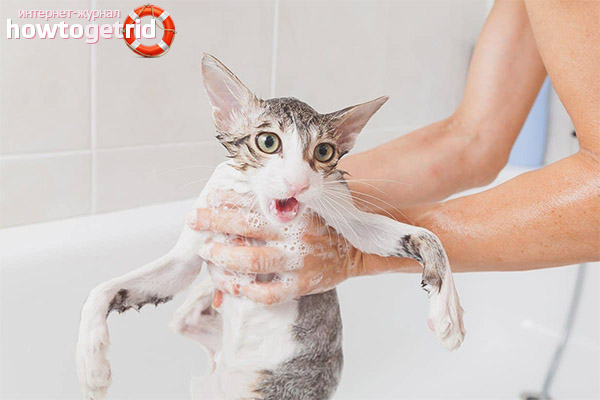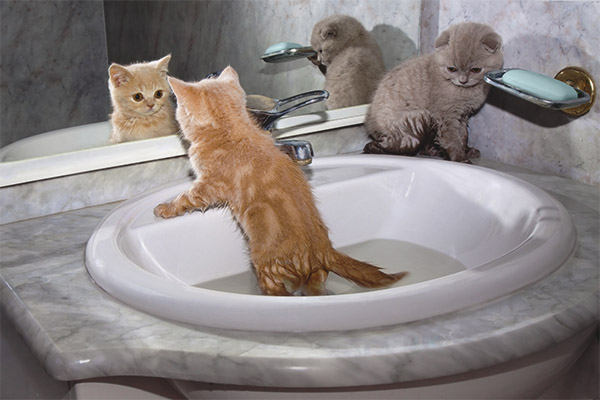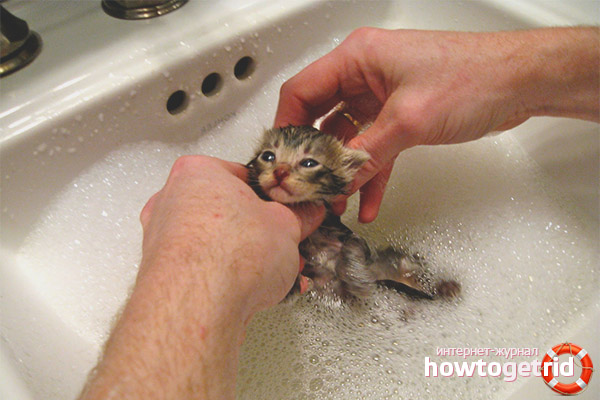The content of the article
Bathing a cat is part of a set of hygienic procedures necessary for any animal. This action takes an important place in the process of caring for your pet. Some kittens quite easily and painlessly accept such an event, while others are clearly not enthusiastic about him and show very turbulent emotions. Any pet owner is ready to do everything so that the kitten’s fear of bathing is minimal.
It has long been observed that the first meeting with water leaves an imprint on all further attitudes towards it. If the water procedure is easy for a kitten, then in the future he will not be afraid of water. Therefore, the first bathing should be carried out with maximum caution and to direct all efforts to the elimination of errors.
The pet owner must clearly understand that a cat simply cannot do without bathing.The procedure is simply necessary for the animal, despite the fact that he wears a flea collar. Of course, there are breeds of cats (Manx, Canadian Sphynx), which do not bathe at all, because this procedure can have significant stress on them. But this, for the most part, is the exception rather than the rule.
Time to start taking water treatments
If there is an urgent need to bathe a monthly kitten, then the process should be approached with the utmost caution. It is extremely important to control the temperature of the water in order to avoid hypothermia. You should not rush to send the kitten into the water, if recently he was vaccinated. After it should be kept for at least two weeks.
Bathing frequency
The one who bathes a kitten weekly makes a big mistake. In no case should this be done. It is always necessary to remember that bathing for a cat is stressful. But there is another unpleasant moment. If washing is done frequently, the grease that disappears from the wool disappears, which serves as a protective coat for the coat. Of course, from this the appearance of the pet will suffer.
The frequency of water treatments is determined by the time of year. Depending on the season, the bathing scheme can be represented as follows:
- Winter - one-time swimming for the entire season.
- Also wash the cat once in the fall.
- In summer and spring, the kitten is washed twice per season.
The cat has a natural cleanliness, and more frequent bathing is simply not necessary.
Means for washing kittens

Of course, the shampoo that a person uses is absolutely not suitable for cats. This is due to various pH values in animals and humans. Regular shampoo can not be used because it will ruin the elementary animal's hair. If the kitten is casually a little dirty, you can simply wipe it with a damp cloth.
Types of shampoos
Means for washing animals can be used in various aggregative states:
- Liquid shampoos. They apply to both kittens and adult cats. If you apply a suitable shampoo, then the pet will have a soft and silky coat. Use the tool in small quantities. Otherwise, it will be very problematic to wash off the copious foam afterwards with a quality wash.
- Dry shampoos. Their use is resorted to if the animal has a pronounced panic fear of the type of water. After application to the body, combing is performed. Contamination will be removed in parallel with excess wool. In comparison with liquid products, shampoos in this form are shown for more frequent use. This is due to the fact that they are not able to clearly disturb the acid-base balance. Its use can be started when the kitten is 3 months old. Drawing is carried out only on a dry surface of a body.
- Detergent in the form of a spray. In this form, it is allowed to apply shampoos to a wet body. Application begins at the age of 6 months, since such funds have a pronounced odor.
For kittens and adult cats use different shampoos.If you wash the kitten with shampoo intended for an adult cat, dermatitis may develop.
First swim: instruction
First of all, it is necessary to create optimal conditions in the room where the bathing will take place. The room should be warm and dry. The kitten must be completely healthy. If the animal is sick, you should not bathe it. For those who are bathing a kitten for the first time, you can make a few recommendations:
- Bathing is carried out in the pelvis. You should prepare a soft towel and a special shampoo for kittens. You can immediately open the detergent.
- Naturally, you need to wear an apron and clothes that are not sorry. We must be prepared for the fact that the kitten starts to scratch and can simply damage your belongings.
- Water is poured into the basin at room temperature. It is enough if the water layer is a couple of centimeters from the bottom.
- Two cotton balls soaked with petroleum jelly are placed in the kitten's ears. This will prevent water from entering them. In addition, the animal will not hear the noise and splash, which for him are additional irritants.
- The left hand holds the kitten by the withers and the pet is seated in a basin.It does not matter what position the kitten will take in the basin, if only he is firmly entrenched in it.
- It is then rinsed with water from a shower at a predetermined temperature. Water pressure should be low.
- Water is not necessary to water the head. On it, you can just hold a wet towel.
- Then a few drops of shampoo are applied to the coat. One hand should hold the kitten, and the other evenly distribute the shampoo over the surface of the body.
- Some time (see instructions) shampoo should be on the body. After that, it is thoroughly washed off.
- Taking the kitten out of the water, it is wrapped in a towel. At the same time the head is not wrapped.
- After 5 minutes, the kitten is freed from the towel.
If the first bathing is carried out competently, then the kitten in the future will not experience a strong fear of water. This will determine that his mind will experience less stress, and your pet will always be clean. In addition, a properly selected shampoo will ensure the smoothness and silkiness of the pet's hair.
In the event that the pet is shy enough, but clean, you can not bathe it, but simply wipe the paws with a wet towel. At the age of two months, bathing can be carried out just with warm water, without using shampoo. Starting from three months, you can use a special shampoo for kittens.
If all the conditions are met, the kitten from the first swim will only have pleasant associations, and in the future it will cease to be very afraid of water.
Video: how to bathe the kitten for the first time












To send